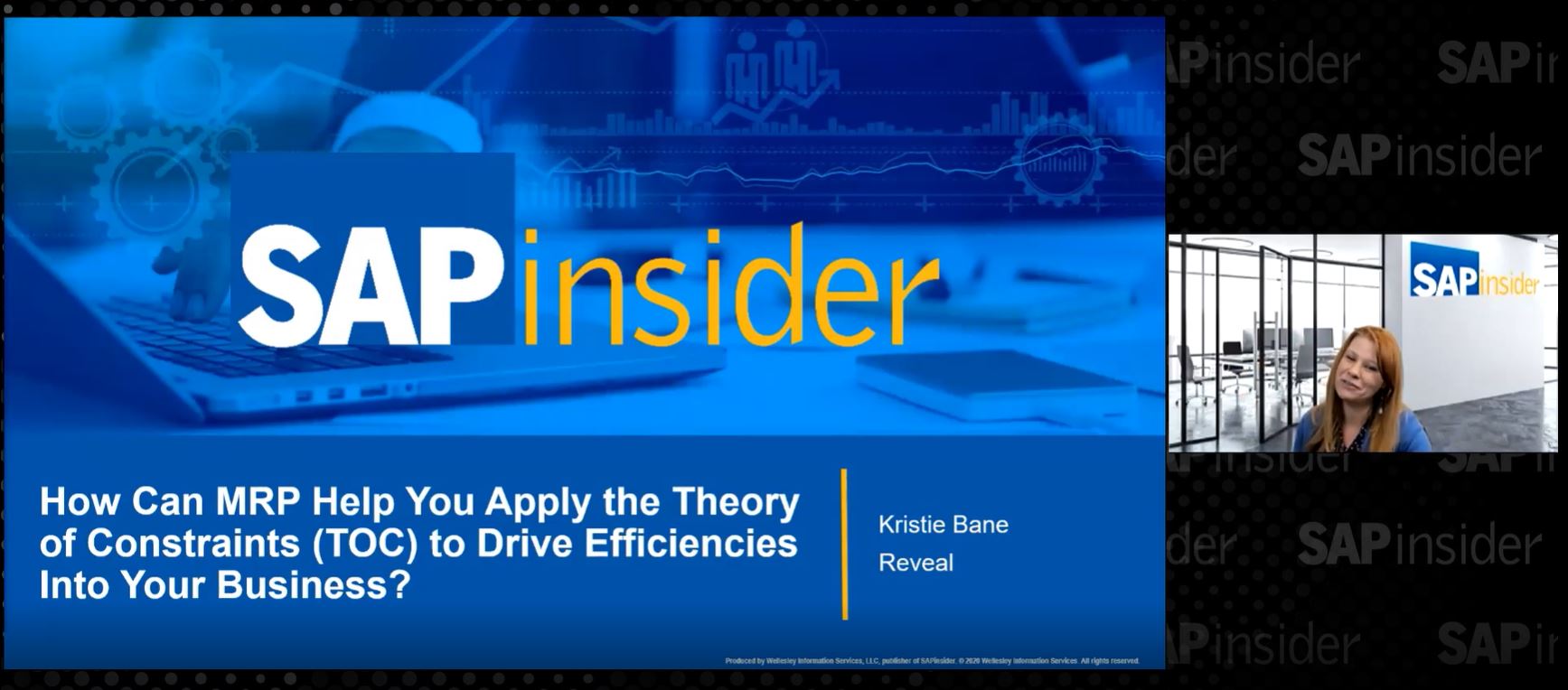Manage Material Requirements Planning Exception Messages in SAP
How to Categorize and Evaluate Exceptions into Plan, Schedule and Inventory Areas
by Venkata Ramana Nethi CSCP, CPIM, Business Process Lead – Operations, Schlumberger
Exceptions generated via material requirement planning (MRP) on the MRP elements should be evaluated daily or, at a minimum, weekly. Managing MRP exception messages effectively at the operational level is an essential business activity because these messages impact operational key performance indicators (KPI). Depending on the organization size and product volumes there could be hundreds or thousands of MRP exception messages. Managing exception messages can be difficult without the planning department following a structured process. Mismanagement could impact the bottom line, which in turn affects customer satisfaction.
In this article you will:
Explore related questions
- Learn how to categorize exceptions generated via material’s stock requirements list into plan, schedule, and inventory areas
- Gain a firm understanding of types of MRP-generated action messages with standard operating procedures on exception management
- Understand how to set up tolerances to get actionable MRP exception messages and minimize nervousness
- Translate MRP exception messages into business actions from the perspective of a master scheduler, planner, and purchasing role
by Venkata Ramana Nethi CSCP, CPIM, Business Process Lead – Operations, Schlumberger
Exceptions generated via material requirement planning (MRP) on the MRP elements should be evaluated daily or, at a minimum, weekly. Managing MRP exception messages effectively at the operational level is an essential business activity because these messages impact operational key performance indicators (KPI). Depending on the organization size and product volumes there could be hundreds or thousands of MRP exception messages. Managing exception messages can be difficult without the planning department following a structured process. Mismanagement could impact the bottom line, which in turn affects customer satisfaction.
In this article you will:
Explore related questions
- Learn how to categorize exceptions generated via material’s stock requirements list into plan, schedule, and inventory areas
- Gain a firm understanding of types of MRP-generated action messages with standard operating procedures on exception management
- Understand how to set up tolerances to get actionable MRP exception messages and minimize nervousness
- Translate MRP exception messages into business actions from the perspective of a master scheduler, planner, and purchasing role
Categorization of MRP Exception Messages
MRP guarantees material availability. Based on your SAP system configurations, it generates proposals to procure or produce requirements and exception messages that take actions on the MRP elements, based on the system configurations.
A basic responsibility to evaluate MRP exception messages lies with the planner. The exception messages should be categorized into focus areas (plan, schedule, and inventory), as shown in Figure 1.
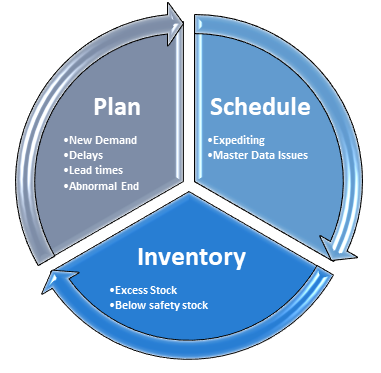
Figure 1 — MRP Exception Messages Grouped into Plan, Schedule and Inventory Focus Areas
Once MRP exception messages are categorized, they require specific actions based on organizational policies, as shown in Figure 2. There is a specific action for each MRP exception message. However, one person or team can’t fix all the issues; it requires coordination across multiple cross-functional teams to minimize the impact. Figure 2 shows the focus areas and the exception message numbers related so only those should be analyzed to achieve the goals in the focus area. Once this analysis has been completed you can distribute the focus areas to suit your organizational structure.
Note: There are a few more exception messages, which show up due to incomplete master data set up or specific customizing settings. Treat these as separate, rare cases.

Figure 2 — A System of MRP Exception Message Monitoring
Let’s see how to minimize nervousness in MRP systems in the following configuration system set-ups to achieve an actionable list of exception messages. The following sections also explain how to evaluate exception messages via MD06/MD07 transactions and understand the results screen, followed by recommended actions from the perspective of a master scheduler, planner, and purchasing role.
Minimize Nervousness Using Tolerances
In a perfect world, zero exception messages means the system is optimized to the business processes. However, a perfect world oftentimes is not practical considering the dynamics in supply chain. Planners are tasked with managing exceptions to minimize impacts at the execution level by following two steps:
- Establish realistic parameters on material master MRP views, which is an ongoing process.
- Review the tolerance value configuration at both the plant and the MRP group level using transaction OMDW to suit the products produced or procured. Doing this begins to eliminate messages that are not practically possible to react to. For example, if an organization’s product lead time range is one to three months or longer, then it is not practically possible to act on supply MRP elements like purchase order or production order to change the dates suggested by MRP for short differences.
The following sections explain how to set up tolerances.
Scenario
A plant based in the United States manufactures products with medium to long lead times. This plant operates five days per week and decides that it doesn’t make sense to move the orders when there is a difference of only three workdays to reschedule in and 15 workdays to reschedule out on a pegged relationship between demand and supply. The plant applies business rules to generate the actionable exception messages only via the following described configurations so the planners can take appropriate business actions to resolve the situations.
Configuration Set Up
To achieve their business objective the plant applies the following tolerances in their SAP system on both ‘reschedule-in’ and reschedule-out’ exceptions:
- Reschedule in – business wants 3 calendars days (which will be 3 workdays, assuming 5 workdays per week)
- Reschedule out – business wants 21 calendar days (which will be 15 workdays, assuming 5 workdays per week)
Note: Exception messages are usually calculated based on workdays.
When using transaction OMDW for configuration, the tolerance is set at plant level, which is applicable to all the materials in the plant, as shown in Figure 3.
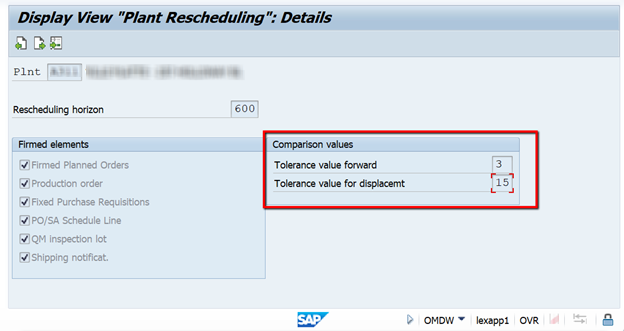
Figure 3 — Plant Rescheduling Configuration Using Transaction OMDW
- Tolerance value for bringing forward receipt elements: Number of workdays used by the system to create a rescheduling proposal in the planning run to bring forward a firm receipt element that lies after the requirements date.
- Tolerance value for displacement in the future: Number of workdays used by the system to create a rescheduling proposal in the planning run to displace firm receipt elements that lie before the requirements date.
A separate tolerance can be set on MRP group level when required, as shown in Figure 4.
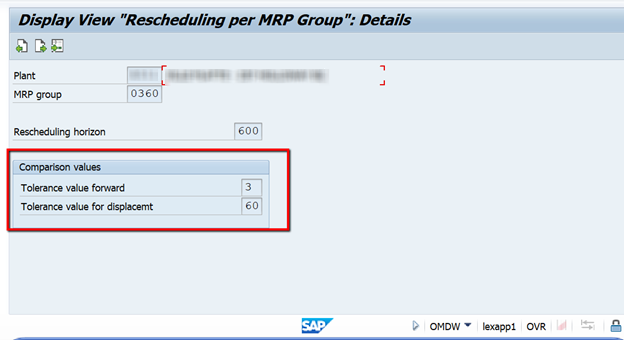
Figure 4 — Rescheduling per MRP Group Configuration
Traffic Lights Set Up
Setting the MRP exception messages should be managed on an ongoing basis in order to maintain accuracy of MRP planning. Figures 5 and 6 display how to configure the traffic lights and interpret MD07 results.
The user can define threshold values for traffic lights by exception message and number of days. The current on-hand stock will last with reference to demand.

Figure 5 — Define Traffic Light
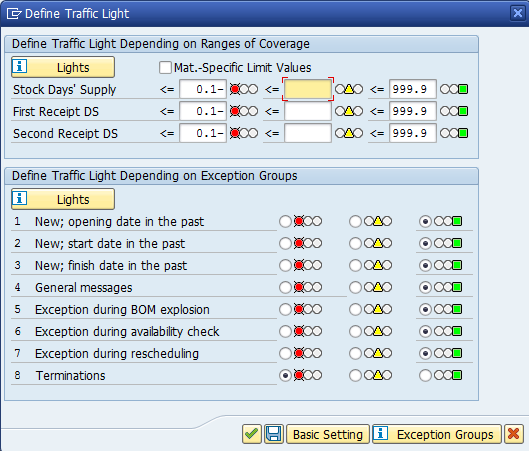
Figure 6 — Configure Traffic Lights
Understand Stock Out Situations
Businesses should define the stock days of supply (StockDS) range into categories. The following list provides an example of stock out based on days of supply and recommended actions. These values may differ per organization, but the concept works for any group of products selected.
- Immediate action required (< 0 days of supply)
- Stock out approaching soon (0 – 10 days of supply)
- Adequate inventory (10 – 20 days of supply)
- Excess inventory (> 20 days of supply)
Figure 7 displays an MRP exception message analysis and a review of the stock out severity for the values of StockDS with recommended actions. This process can be applied for various products lines.
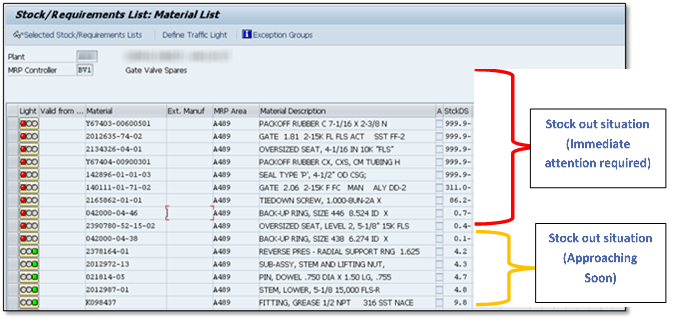

Figure 7 — Exception Messages with Traffic Lights: Understand Stock-out Impact Based on StockDS
Analyzing MRP Exception Messages
Analyzing the MRP exceptions at the aggregate level at one or more plants and being able to narrow down to the order level is required on a periodic basis to review and resolve the exception. Using the SAP business intelligence (BI) report makes it easier to integrate the detailed data from the stock requirement list (MD04) and is the recommended approach, but some organizations may not have well-developed SAP BI reports. Therefore, the following sections explain two different ways to analyze MRP exception messages: via spreadsheets, and via SAP BI reports. Choose the method that best suits your organizational model.
- Via spreadsheets: Download the MRP exception message report on a weekly basis, options to review with cost impact (weekly is minimum, daily is recommended)
- SAP BI reports: Streamline reporting and avoid workarounds
Analyze MRP Exception Messages Using Spreadsheets
Use transaction MD07 to download a stock requirement list to Excel to review offline. On the display screen, follow the menu options to download into spreadsheet. Select menu option list, then print, as shown in Figure 8.
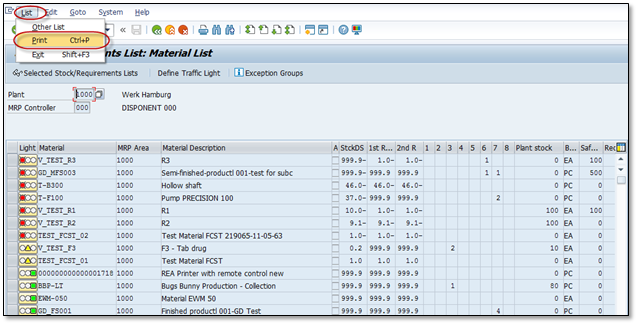
Figure 8 — MRP Exception Message List (MD07 Transaction)
On the display screen, click the download icon, as shown in Figure 9.
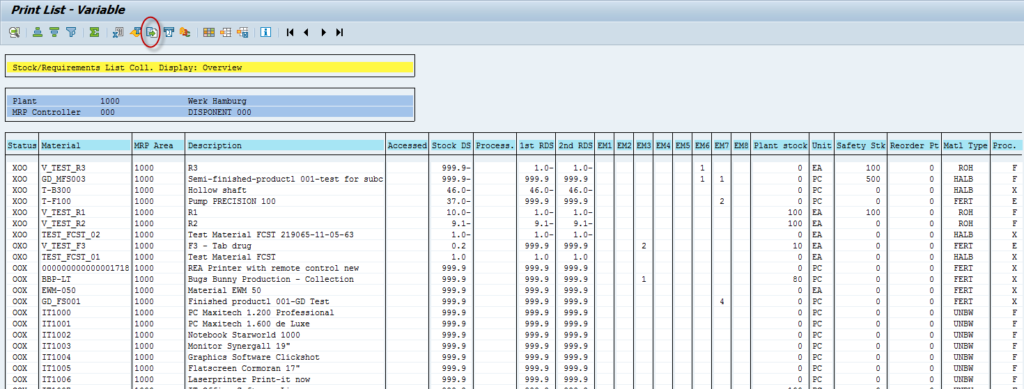
Figure 9 — MD07 Transaction, Print List—Variable Screen
Next, select the spreadsheet radio button, as shown in Figure 10. Enter your local drive path to save the results.
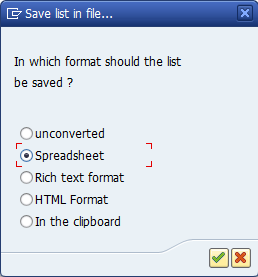
Figure 10 — Select Download Format
Figure 11 shows conditional formatting that you can apply in Excel to define traffic lights. This method Is suggested for ease of analysis.
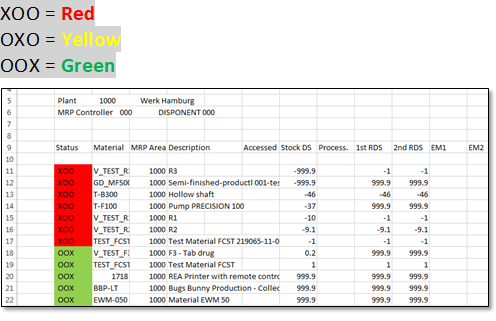
Figure 11 — Conditional Formatting for Traffic Lights in Excel
To assist in the decision-making process, display results as a table or graph. You must use stable data and be sure to provide the information a day before your inventory meeting.
Figure 12 showcases an example from an organization having significant impact on dollars due to reschedule-in, reschedule-out, and cancel process exception messages. You can imagine the efforts of expediting which may require airfreight and strong collaboration from the manufacturing plant and supply chain and evaluate production variances approval.

Figure 12 — MRP Exception Messages with Dollar Impact in Years 2018, 2019 (Summarized)
Note: Refer to Figure 2 for the exception message numbers for the ‘Expedite’ area of focus.
Analyze MRP Exception Messages Using SAP BI Reports
Managing the data in spreadsheets may be the best option for some organizations but by leveraging SAP BI reports you can develop a BI report that shows a daily extract of exception messages from the stock requirements list into BI. You can also slice and dice the data to the required level and review results in either tabular or graphical format to assist in the decision-making process. Figure 13 demonstrates how one organization followed this method.

Figure 13 — Sample Selection Screen from SAP BI Report
Figure 14 shows aggregated output of two plants from SAP BI.
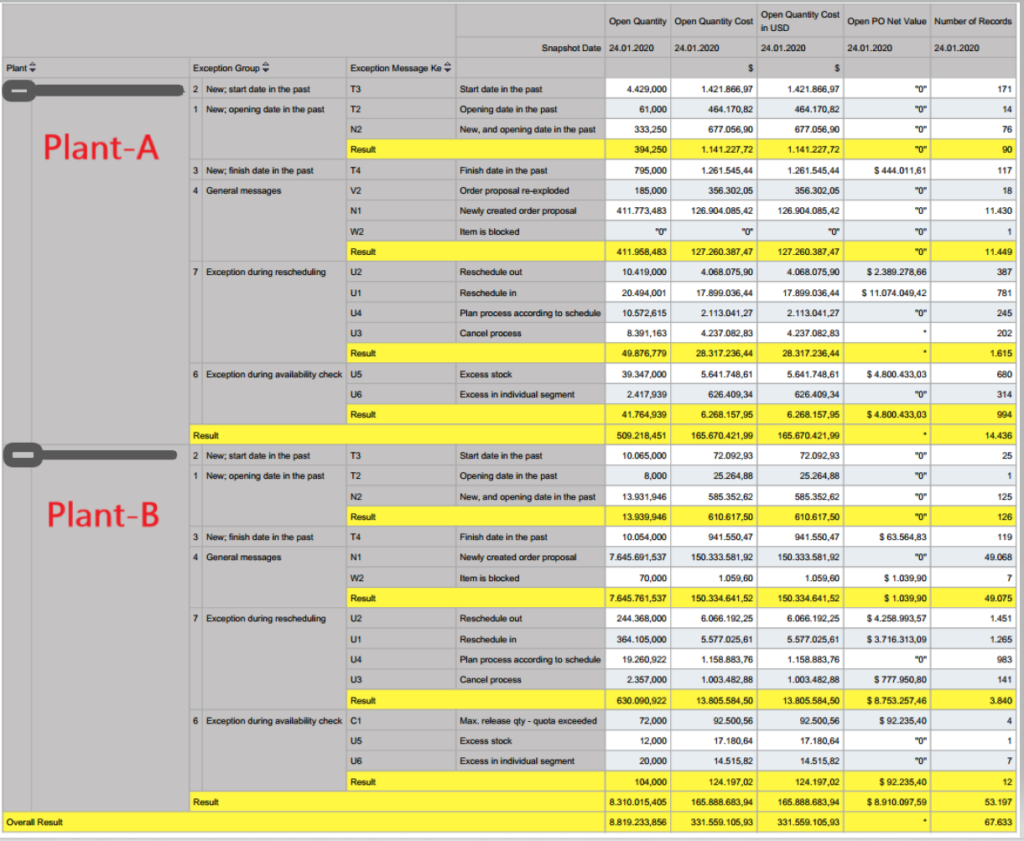
Figure 14 — Aggregated Output from SAP BI
Figure 15 shows required level for analysis drill downed to MRP element and procurement type from SAP BI.
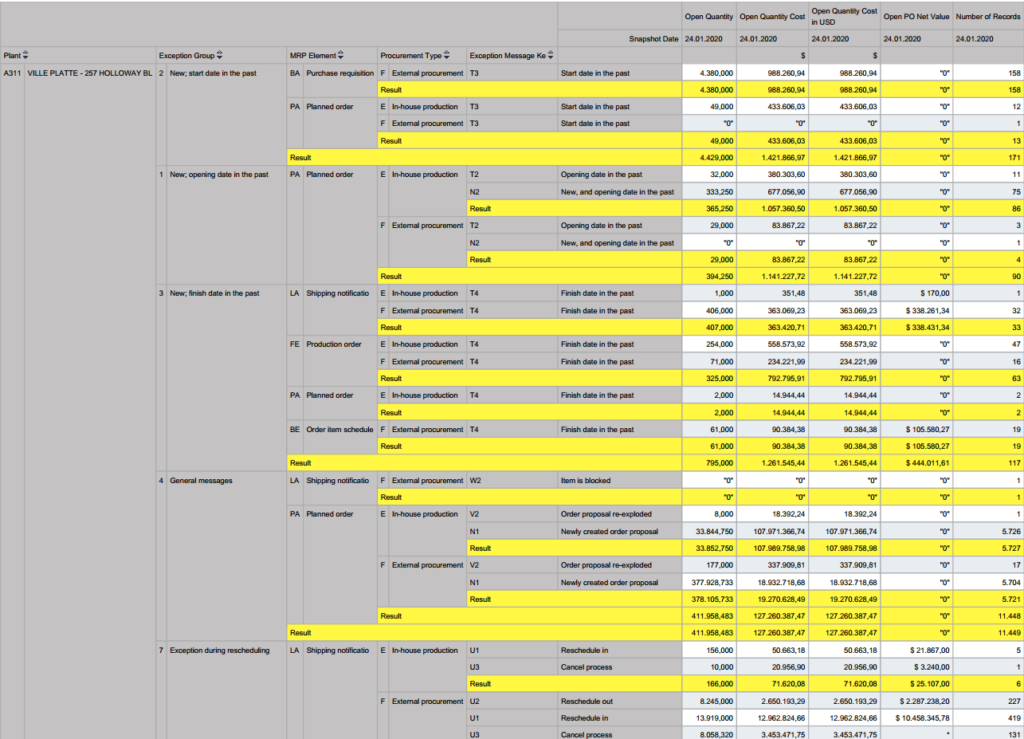
Figure 15 — MRP Element and Procurement Type from SAP BI
What Does This Mean for Master Schedulers, MRP Planners, and Purchasing Teams?
Master schedulers, MRP planners, and purchasing teams have three primary responsibilities:
- Ensure smooth flow of materials into plants or factories
- Facilitate increased communication and coordination between all parties
- Identify and fulfill material and resource requirements based on established plans, including upstream and downstream integration
The way analysis is conducted on MRP exception message groups will differ depending on who is performing the analysis (master scheduler, MRP planner, or purchasing team). The below sections highlight the guidelines from a discrete manufacturing and service industry where products procured and produced are based on forecast or customer orders. These guidelines should be applicable for most organizations that have planners take actions based on exceptions.
MRP Exception Management Guidelines for Master Schedulers
Master schedulers can take the following steps:
- Access the collective access tab using transaction MD06/MD07
- Enter selected MRP Controllers relevant for master schedule and select exception groups 2 / 3 / 7, as shown below in Figure 16

Figure 16 — Exception Groups 2 / 3 / 7 for Master Scheduler
- Define traffic lights, as shown in Figure 17
- Note: Traffic light values depend on the average product lead times; the checkboxes will reset when MRP runs on the material and plant combination
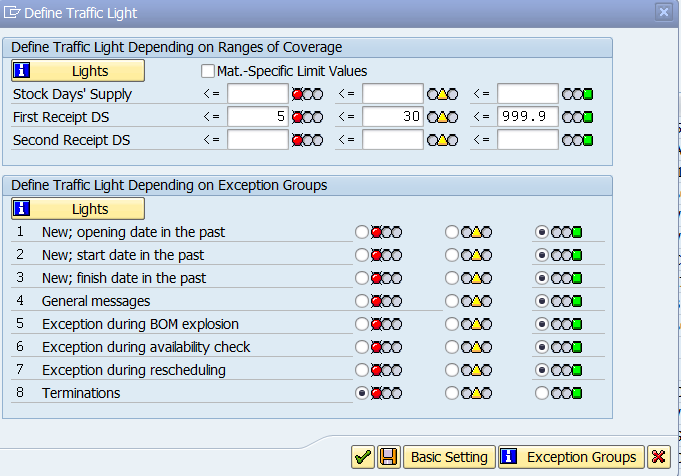
Figure 17 — Define Traffic Light Screen
Depending on the lead time, it is recommended that master schedulers use the Figure 18 to resolve exception messages.

Figure 18 — Guidelines for Master Schedulers to Resolve Issues on Select Exception Groups
MRP Exception Management Guidelines for MRP Planners
MRP planners can take the following steps:
- Access the collective access tab using transaction MD06/MD07.
- Enter MRP Controllers used for master
- Schedule and select exception groups 2 / 3 / 5 / 7, as shown in Figure 19
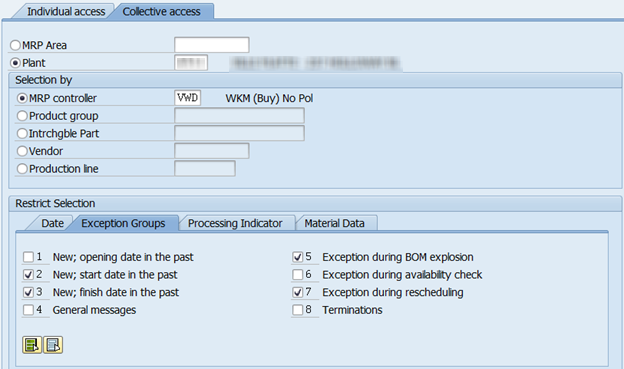
Figure 19 — Exception Groups 2 / 3 /5 / 7 for Manufacturing Planners
Note: See Figure 17 to define traffic lights.
Table 1 identifies possible causes for delays or shortages and what business action should be taken to resolve exception messages.
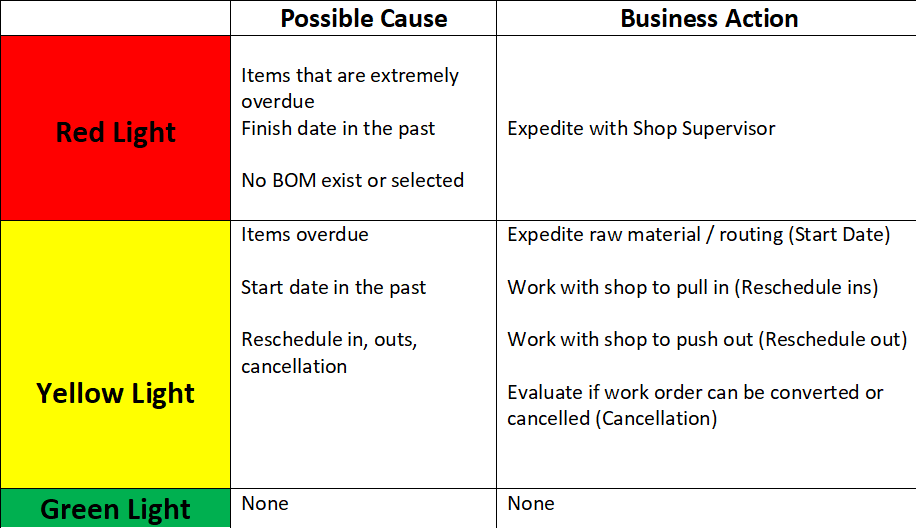
Table 1 — Possible Causes and Recommended Business Actions for Manufacturing Planners
MRP Exception Management Guidelines for Purchasing Teams
Purchasing planners or procurement teams can take the following steps:
- Select exception groups 3 / 7 with relevant MRP controllers at selection screen, as shown in Figure 20

Figure 20 — Purchasing Teams Exception Groups Selection Screen
Traffic light working priority list should be to process all red lights, then yellow lights. Purchasing team members refer to Table 2 to resolve exception messages with recommended business actions.
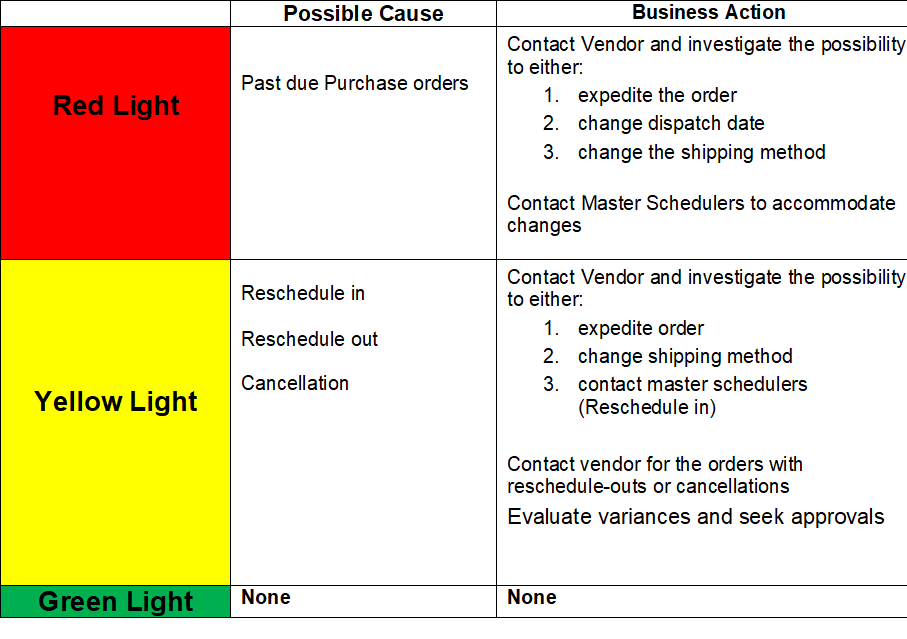
Table 2 — Possible Causes and Recommended Business Actions for the Purchasing Team
Select binoculars for order details as explained in the following sections.
Drill Down to Order Level to Take Actions
At the execution level, the production supervisor or purchasing person should act on the orders causing exceptions. Answering the following questions is required to adhere to the plan in short-term horizon and make necessary adjustments to meet master plan:
- Can we convert anything else?
- Can we procure internally from another plant via stock transport orders (STO)?
- Can we locate domestically?
- Can we air freight using UPS Red?
Steps to Find the Production/Purchase Order Causing MRP Exception
Select “Find MRP Elements” tab, then select MRP elements “PO ACK” and “PO Item.” Enter date one day prior (yesterday’s date). This will pull up all past due purchase orders (same information as red lights), as shown in Figure 21.
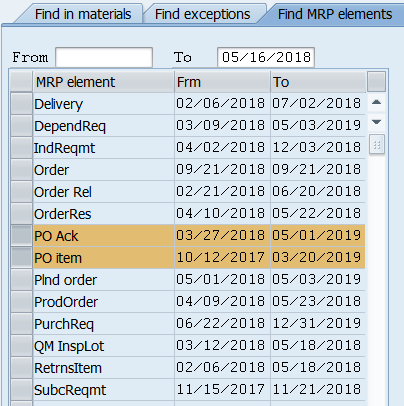
Figure 21 — Find MRP Elements
Click binoculars and select “Find Exceptions” tab, then select “10 – Reschedule ins” (Figure 22). This will provide a list of all materials with a reschedule-in message. You can do the same for exception messages “15” and “20.” Order of priority is 10, 20, 15.
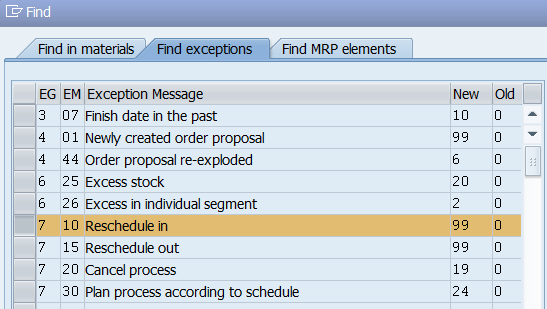
Figure 22 — Find Exceptions Screen
After you enter the selection criteria all the material numbers with that exception message will be highlighted (Figure 23).

Figure 23 — Material List
Double-click on the first material highlighted to open stock requirements list, then select the “Overview Tree” to start working messages down the list (Figure 24).
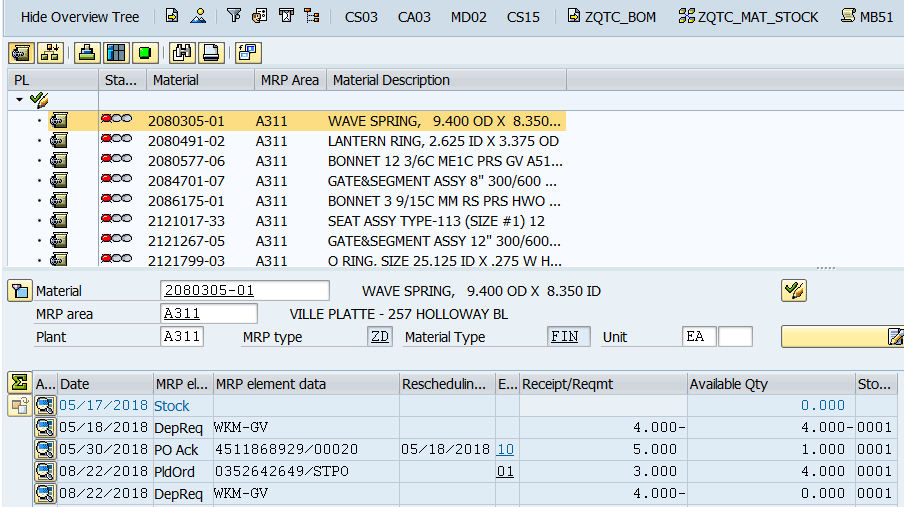
Figure 24 — Expanded Overview Tree
Set the check box for each material from the MD04 screen without returning to the main MD06 screen. Repeat this process as required.
The old way of monitoring and managing MRP exceptions was to handle each order as a separate entity but the new way is to handle exceptions with an aim to standardize the process. The guidelines described in this article should help your organization develop effective methods to monitor and manage MRP exceptions to achieve operational goals.
What Does This Mean for SAPinsiders?
- Categorization is the key. The execution processes in a manufacturing or service firm requires changes to be made on short notice for efficient usage of materials and resources. An effective process should be in place using the exception message report (MD07) or SAP BI report to identify the most critical exception messages used to manage exceptions. MRP exception groups should be categorized into plan, schedule, and inventory areas with dollar impact for review and proposed business actions for the situation to achieve higher service levels.
- Minimize nervousness in MRP. MRP systems are well defined with predefined techniques in standard processes. Delays from vendors or inefficiencies on the shop floor cause nervousness in the system, leading to a huge volume of exception messages. These cannot be managed by the planning team alone. Define the tolerances to suit your organization’s standards to generate actionable messages for monitoring and possible actions to fix the situations. This will help you achieve savings on inventory carrying costs and optimize time to release manufacturing and purchase orders.
- Define role-based action plan. An operations plan is communicated via the master schedule to drive the material requirement plan based on the inputs from sales and operations planning (S&OP), however the success in delivering the plan is in the hands of execution-level roles, such as the master scheduler, MRP planner, and purchasing teams. Research indicates that there should be guidelines to translate the SAP MRP exception messages into business actions to maximize both machine and labor utilization with the factory. Define possible action items per role with an effective communication plan to drive inputs to mid- to top-level management.
- Implement a standardized approach. User training is vital. Managing traffic lights on MRP exception messages is a process, so understanding the meaning and standardized approach is key for success at the execution level. Organizations should adhere to a standardized approach to encourage continuous monthly improvement.
- Leverage SAP tools to assess impacts. MRP exception messages on the stock requirement list are dynamic in nature and it is very difficult to analyze huge volumes. Using SAP BI to obtain a static picture daily for aggregated views and being able to drill down to details helps businesses understand the impact on plan, schedule, and inventory categories. Involve end users during the development of reports with intuitive displays and to measure progress.
You may explore further involving relevant stakeholders in your continuous improvement strategy. The information mentioned here is applicable to small-, medium-, and large-sized organizations.


